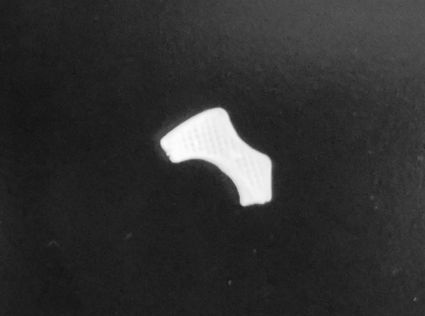Preparation method of 3D printing elastic polymer stent for articular cartilage repair and product and application of 3D printing elastic polymer stent
An elastic polymer, 3D printing technology, applied in 3D printing, joint implants, joint implants, etc., can solve the problems of defect area recovery and poor regeneration, achieve good biocompatibility, preparation method Simple, Growth-Promoting Effects
- Summary
- Abstract
- Description
- Claims
- Application Information
AI Technical Summary
Problems solved by technology
Method used
Image
Examples
Embodiment 1
[0023] A 3D printed elastic polymer scaffold for articular cartilage repair, using 3D printing at room temperature to prepare PCLA / PLGT blend polymer loaded with modified nano-hydroxyapatite and silk fibroin, to obtain elastic and degradable joint repair Implants, prepared as follows:
[0024] (1) Preparation of PLLA-modified PLLA-n-HA by step-by-step reaction: prepare ethanol aqueous solution (90% ethanol) containing 2% (w / v) γ-aminopropyltriethoxysilane (KH550), and add 10% (w / v) n-HA, ultrasonically dispersed, adjusted the pH to 9~10 with NaOH solution, reacted at 70 °C for 8 h, and dried in vacuum at 60 °C to obtain the product KH550-n-HA;
[0025] Dissolve 3 g of KH550-n-HA and 3 g of lactide (LLA) in 30 mL of DMF, and add 0.01 g of stannous octoate as a catalyst, reflux at 120 °C for 24 h, and the obtained product is treated with dichloro After washing with methane three times, vacuum drying at 40°C for 8 h after centrifugation, the product PLLA-HA was obtained;
[002...
Embodiment 2
[0029] A 3D printed elastic polymer scaffold for articular cartilage repair, the others are the same as in the embodiment, except that step (2) is prepared according to the following steps:
[0030] (1) Stepwise reaction to prepare PLLA-modified PLLA-HA, the method is the same as in Example 1;
[0031] (2) Mix 8mL dichloromethane with 2mL DBP, add 3.5g PCLA, 0.5g PLGT, 0.95g PLLA-HA, 0.05g silk fibroin in sequence, fully dissolve and disperse under closed mechanical stirring;
[0032] (3) According to the model design, use a 3D printer in the layer-by-layer accumulation mode to perform 3D printing at room temperature. After printing, the product is placed in a 40°C oven to evaporate the solvent to obtain an elastic polymer scaffold.
Embodiment 3
[0034] A 3D printed elastic polymer scaffold for articular cartilage repair, the others are the same as in the embodiment, except that step (2) is prepared according to the following steps:
[0035] (1) Stepwise reaction to prepare PLLA-modified PLLA-HA, the method is the same as in Example 1;
[0036] (2) Mix 5mL dichloromethane with 5mL DBP, add 1g PCLA, 0.6g PLGT, 0.38g PLLA-HA, 0.02g silk fibroin in sequence, fully dissolve and disperse under airtight mechanical stirring;
[0037] (3) Use a 3D printer in the layer-by-layer accumulation mode to perform 3D printing at room temperature. After printing, the product is placed in a 40°C oven to evaporate the solvent to obtain an elastic polymer scaffold.
PUM
 Login to View More
Login to View More Abstract
Description
Claims
Application Information
 Login to View More
Login to View More - R&D
- Intellectual Property
- Life Sciences
- Materials
- Tech Scout
- Unparalleled Data Quality
- Higher Quality Content
- 60% Fewer Hallucinations
Browse by: Latest US Patents, China's latest patents, Technical Efficacy Thesaurus, Application Domain, Technology Topic, Popular Technical Reports.
© 2025 PatSnap. All rights reserved.Legal|Privacy policy|Modern Slavery Act Transparency Statement|Sitemap|About US| Contact US: help@patsnap.com

